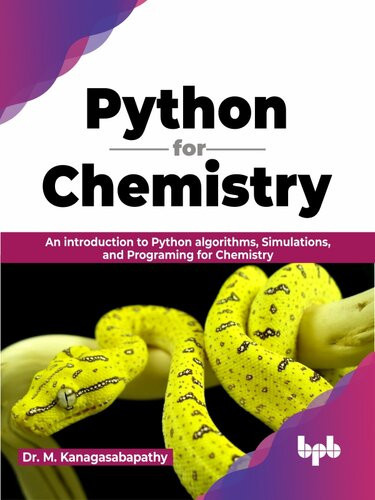

Most ebook files are in PDF format, so you can easily read them using various software such as Foxit Reader or directly on the Google Chrome browser.
Some ebook files are released by publishers in other formats such as .awz, .mobi, .epub, .fb2, etc. You may need to install specific software to read these formats on mobile/PC, such as Calibre.
Please read the tutorial at this link: https://ebookbell.com/faq
We offer FREE conversion to the popular formats you request; however, this may take some time. Therefore, right after payment, please email us, and we will try to provide the service as quickly as possible.
For some exceptional file formats or broken links (if any), please refrain from opening any disputes. Instead, email us first, and we will try to assist within a maximum of 6 hours.
EbookBell Team

4.4
32 reviewsA one-stop guide to teach chemists how to use Python for coding and iterations in a hands-on and practical manner
Key Features
● Understand the core Python functions and algorithms for the computation of chemical parameters.
● Learn how to use Cheminformatics modules to process and analyze elemental data and molecular structures.
● Get familiar with the algorithms for numerical and symbolic computations.
Description
Python is a versatile and powerful computer language without a steep learning curve. It can be deployed to simulate various physicochemical parameters or to analyze complex molecular, bio-molecular, and crystalline structures.
The objective of this book is to give a gentle introduction to Python programming with relevant algorithms, iterations, and basic simulations from a chemist’s perspective. This book outlines the fundamentals of Python coding through the built-in functions, libraries, and modules as well as with a few selected external packages for physical/materials/inorganic/analytical/organic/ nuclear chemistry in terms of numerical, symbolic, structural, and graphical data analysis using the default, Integrated Development and Learning Environment. You will also learn about the Structural Elucidation of organic molecules and inorganic complexes with specific Cheminformatics modules. In addition to this, the book covers chemical data analysis with Numpy and also includes topics such as SymPy and Matplotlib for Symbolic calculations and Plotting.
By the end of the book, you will be able to use Python as a graphical tool or a calculator for numerical and symbolic computations in the interdisciplinary areas of chemistry.
What you will learn
● To fetch elemental, nuclear, atomic or molecular data with list or dictionary functions.
● Understanding the algorithms for the computation of Thermodynamic, Electrochemical, Kinetics, Molecular and Spectral parameters.
● Stoichiometrical calculation of the reactant and product coefficients from Matrices.
● Symbolic